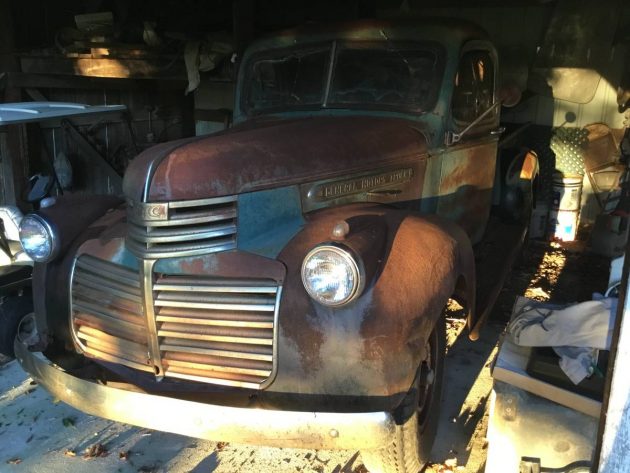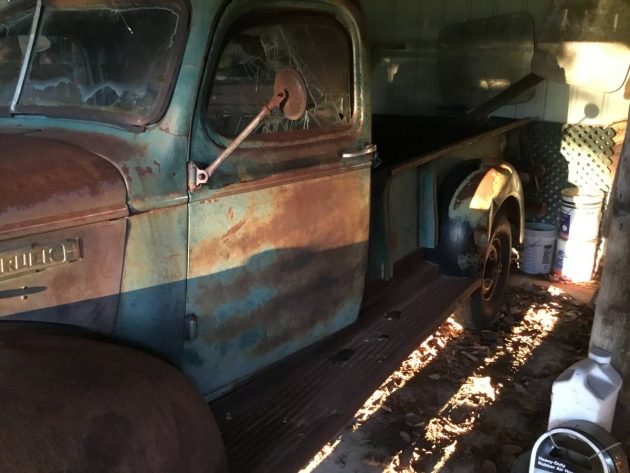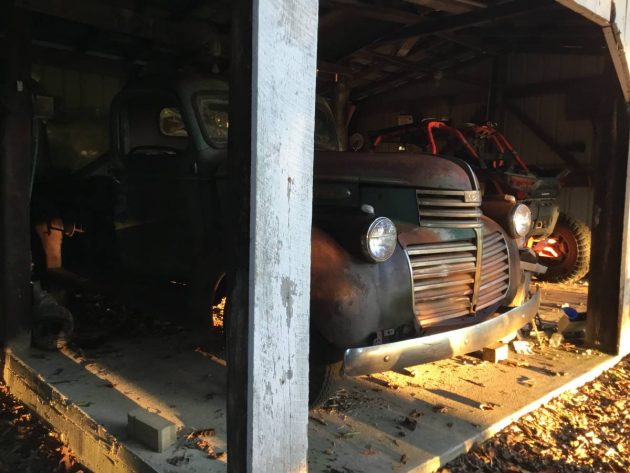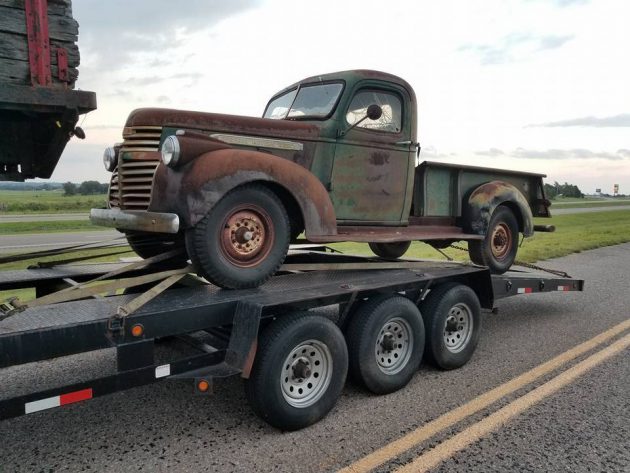Every once in a while, one of the writers at Barn Finds does a write up on an early postwar Ford or Mercury pickup truck. Usually, these trucks have been rescued off farms in Canada or the Midwest. While it is widely acknowledged that Ford trucks have a strong following, it seems odd that General Motors trucks of that same period don’t garner as much interest. It isn’t as if Chevrolet, and its badge engineered GMC cousin, aren’t good, sturdy trucks. In addition, to my eye, the styling is just as appealing as that of any Ford. What it may be is that people just love the Flathead Ford engine, the inline six resting under the hood of these trucks is a good truck engine in its own right. Whatever the reason, this leaves to enthusiasts a larger number of GM trucks to choose from. One such truck is this 1947 GMC pickup, found in Adolphus, Kentucky on craigslist. This old farm hand looks to be a good restoration project, but is the $5,500 price reasonable in this case?
This truck, and its Chevy brothers, were produced from 1941 through 1947, with production being halted during the war. The production line was cranked up in mid 1944 however, to satisfy the need for new trucks on farms and for essential industries. When Japan surrendered, these “Art Deco Series” trucks were back in full production just six days after the ceremony in Tokyo Bay. Production ran until 1947, when the new series, called the “Advanced Design Series,” debuted in 1947. Production of each type of truck overlapped for about two months, so it would be interesting to see if this truck was one of the ones produced during that time. The only real difference between the Chevrolet and the GMC versions were the badging and the grill bars. They are vertical on Chevrolets, and horizontal on GMCs.
Sad to say, but the pictures we are given in the ad aren’t the best. When dealing with any vintage vehicle, pictures that honestly depict the condition of the whole vehicle are needed before a trip to the vehicle’s location are in order. Add to that the importance of seeing the condition of the floor, cab corners, and tailgate on an old truck, and you can see why buyers might be clicking the back button in frustration. While the truck looks to be in standard farm vehicle condition, I think we would all like at least a few more pictures of the cab. However, working with what we have in the photos and in the not very chatty ad, I think it is safe to say that this is a pretty solid vehicle.
Of what we can see, the truck would need to have a lot of dents and scrapes massaged out to make it perfect again. The grill, except for the second bar from the bottom on the passenger side, looks to be useable. The bumper may be bent a bit, but it is hard to tell from the photograph. Adding to the list of needs, all of the glass and the associated rubber will need to be replaced as well. The glass is standard flat glass, which would have to be replaced with laminated in the front, and the side glass and back glass would need to be tempered after it was cut. Tempered will break into a number of small pieces instead of long, knifelike shards, and is required for safety. This is still cheaper and easier than replacing the curved glass found in later trucks and cars.
Under the hood sits the old reliable in line six cylinder that powered so many General Motors products over the years. While Ford got a lot of glory for having a V-8 under the hood, an inline six cylinder is a very good light truck engine. Engines of this type are known for smooth running and lots of low end torque. While details on this truck are scarce, a little digging suggests that this one is powered by GMC’s heavier duty version of the inline six engine, with 238 cubic inches of displacement. We can also see that the truck is equipped with a heater, and the whole engine bay looks to be in stock condition.
The seller states that they “just got back with this truck from out west,” and the picture above was assumedly taken on that trip. Being the best picture of all, we can see that it is equipped with eight lug rims. This, and what looks to be an extended wheelbase, lead us to believe that this was a 3/4 ton truck. There is nothing wrong with that, other than a bouncier ride from the heavier springs and a little extra length to deal with when maneuvering, but 1/2 tons tend to sell for more. We can also see that the driver’s side cab corner looks intact, and that the front fender, running board, and the rear fender are all in need of work.
If the rust throughout the truck is limited to surface rust, and the engine is not damaged, than this tough old GMC could be worth the money as a project. A restoration would quickly run past the point where you could get out of it financially unscathed, but you don’t buy this kind of vehicle for an investment. You buy trucks like this because they are easy to restore, charming in their own rough and tumble way, and they still can be pressed into service as a working vehicle. You just have to determine how nice you want to make it.








I really have a soft spot for old pickups.
I have a 54 Chevy 3100 with the 235 in-line six.
This one looks fairly straight on the body and one can assume a rebuild will be needed on the engine.
The engine rebuild was easy on mine and fairly uneventful. These engines are nicknamed stove bolts as they are cast iron which sometimes makes cracks in the head and mostvswao then for another used head to rebuild .
The starting up of these require the valves and timing “dead on” alignment to start as the distributor moves centimeters not inches like old muscle cars .
The earlier grill is very cool looking on these oldies.
Attached is My 54 3100 is in final prep stages to go to paint shop soon.
It belonged to a friend of my late dad who drove it til 98 on a farm and yes the fenders had many little dings too. 😉
Very cool,and right now, all of us east of Arizona
are “eyeing” that heater with fondness!Looks like it
is pretty original,and mostly complete,should be
a good truck to re-do.I like that it is a GMC,..
kinda like Mercury was to a Ford..,that will
set it apart from the sea of Chevys at most events.
I would make it -close to original appearance wise,but
with some modern upgrades -power steering/stereo/….–maybe even a/c?,
although right now that would be last on the”list”…LOL
Too much $$$ for a truck needing total resto, IMO.
Why does it look like there is a gap between the bed and the cab in the last picture?
Brian, hard to tell from pictures but a lot of these working farm trucks had a hydraulic tilt box. My 55 merc 350 has that with 9 foot box and wood sides. Before in land grain terminals, and farmers did’nt need a thousand acres, thats how grain was hauled. Every small town had an elevator. Good old days?
I think that’s an optical illusion. The cab curves on the back corner, and the bed has that vertical rib that does not sit at the front corner of the bed. It sits back a bit. That gives the impression of a gap at these photo angles. As for the cost, this looks very complete, so a $4k-$5k cost is probably about right if its babbitt bearing engine runs. There are $2.5K trucks out there, but they need even more work. Things like the original rear fenders are getting to be rare. I have a 41 chevy pickup, and there are many parts available. The 4 speed transmission has the granny gear – the 3 speed is harder to find, but preferred. I think the 1/2 ton trucks look better, but finding one this complete will probably cost you a few dollars more.
bumps and bruises are to be expected.. and, a shiny new paint job would look out of place ( for me anyways) if the stovebolt can’t get up n running, a newer straight six would probably do the trick ( early 70s?) make sure it will pass state inspection, a tweak every here and there ( replace what needs to be replaced with something better than stock) it would attract a lot of attention .I would imagine it has a wood box, and if so, replace the wood
Once I am done with my Spitfire, I would like to take on a period GMC or Chevy truck. But I’d shoot for a flatbed because I like light duty commercial trucks. Something around 1.5 tons, but not a super long bed either.
Gotta love old trucks like this.
It’s a 3/4 ton or even a tonner. They were nice tough trucks in their day (and even now). This would likely be powered with a 228 motor. It’s not any more powerful than the 216 that a comparable Chevy ran but it offered full pressure lube which definitely kept the rods oiled up. Not a fast cruiser, you’d be able to do 55 but I wouldn’t push it any further. I like this truck and would be interested in taking a project like this on. You’d be the lone wolf at the car show….
The big difference between the Chev trucks of that era and the GMC, was that the GMC engine was not only slightly larger, but it had positive oiling as opposed to the dippers on the Chev engine. Back in the 50s, we did things to a GMC 6 banger that no Chev engine could have withstood.
This isn’t meant to bad mouth the Chev car and light truck engines, they were perfectly adequate for the time.
Hi Bob. Yes, the GMC motor was definitely built for harder work than the Chevy. Interestingly enough, a lot of Chevy 1 1/2 ton and 2 ton trucks used that old babbit-pounder 216 and I was amazed at how well they took the punishment. We had neighbors who would load 250 bushels of wheat (about a 15K pound payload) and haul it on the back of that ol’ ’51 Chevy with a 4-speed and 2-speed axle. It took five miles down the road just to get them into high gear. I remember helping the neighbors harvest one year. They had a hired man came from somewhere in eastern Europe. He drove the guy’s ’49 Chevy 1 1/2 ton without realizing that there was a 2 speed axle. He came into the field after dumping a load and said: ‘Dur’s a ‘knook’ in da ‘enchun.’ He must’ve been deaf because it turned out there were SIX ‘knooks’ in da ‘enchun.’ All (6) rods were hammered out. The owner parked the truck and doubled up on the other one until after harvest. He brought the truck over to our shop where we pulled the engine and rebuilt it. In the end, the crank wasn’t badly damaged. We sent the rods out and got them re-babbitted, stuck in a set of rings, ground the valves, and the truck went back to work. I still think of that truck, like my ’49 Chevy Styleline, motor in great condition with 15 psi oil pressure cold and 10-12 hot.
The article states the engine is a 238… The GMC blocks were an inch and a half longer than the Chevy… came in 228, 238, 248, and a 270 which had a heavier block than the other three… beautiful engines… easy to work on.
My late father-in-law would love this truck! I’ll have to send this link to him. He’s not dead, just never on time.
I love the GMC’s full pressure fed bigends and true heavy duty build what a great buy we had GMC trucks here in Australia but they were Canadian origin and had the old 216 and 235 CI engines with splash feed bigends a lot ended up with Blueflames and Holden V8s, this would do up really well put a highway diff ratio in and enjoy
Back in 71 I think it was I was ordered by a judge to part ways wth my candy apple red 58 Chevy Impala 2 door hardtop so in order to get out of jail I reluctantly traded for a 41 Chevy p/u with 392 hemi and 3 speed tranny. I kept braking the u-joints. Well as sad stories go after being once again ticketed for dui I abandoned the truck and moved out of state.
In my next life, I’d have this to go along with the rest of my…uh…toys. ;) One thing, though: wouldn’t the door glass also be laminated?
I love the Chevy and GMC’s. especially the ’41-46’s..back in the very early Seventies the Advanced Designs were everywhere in western Colorado, I had a ’49 5 window. Ill bet there are still a ton of them in old towns like Alma and Leadville on the Western Front Range
Stovebolt engines are so named because the bolts (1/4” round head slotted screws) that hold the sideplate on are the same size and look like the bolts in early stoves.
I was talking with my dad over the holidays (he is 86 now) and one of the topics we covered were trucks like this, and how we wished we could have stopped them from ‘going to the crusher’ in the summer of 77. One of his friends “had a few acres of them in the woods” and when the “new highway came through” the friend was told by the county to “clean up the mess or they would do it for him”. When the winter was over we helped him ‘put a few of the truck in the paper” with little to no interest. Keep in mind this was long before the internet. No one seemed to care about 30-40 year old trucks then. If we were lucky to get the word “outside the county” you were doing good. As the summer came and went and the fall approached, so did the deadline the county gave to have the woods cleared. My buddies and I helped my Dad, help that friend yank truck after truck after truck out of the woods, to the road, on to flat beds and … off to the crusher, being sold by the pound. Pick up after pick up, delivery after delivery, panel after panel, stake beds and so on. We must of hauled 50+ hulks of steel from between the trees. It took us a few weeks working almost everyday. Every so often my Dads buddy would tell is “why he kept this one” or the story behind “when this one was parked”. I must of heard “I drove this one” a dozen times. I was 15. All I cared about was that shiny Trans AM on TV. Now, 40 years later… my wife pines for one for “Lawn Art”. How times have changed
Bill, I hear you. When I moved to a small city in the early 70s I was 28 years old and started looking for something to restore. I could not believe the great stuff that was sitting on farms and even around bliffs and corners of fields visible from the highway. Then it seemed that all of a sudden there were these flat bed semi trucks rolling past every day, each loaded with about 10 crushed relics. I could recognize 57 Ford taillights, T and A type fenders and Chevy grills as the crushers work headed for the pipe manufacturer in Regina. In 1977 I bought a really nice 52 Ford 1/2 ton at an auction and a few years later, when I went looking for a parts truck, the ones I knew about were gone. I did pick up a one ton Merc but only the cab is the same size. Wish I had had a place to put the stuff I found back then.
Yes Ipsco in Regina was the end for thousands of classic iron over the years. The field finds are slim now and most left are hidden away in sheds and barns. But still out there.
Now days, its ebay sharpies parting out old vehicles left and right.
In one respect they are servicing a market, but on the other hand too many nice projects get parted out.
Back in the 1980s used to shop for parts for my 50s and 60s chevy projects and one day at a wrecking yard they scrapped a whole range of the cars and trucks. It was maddening as I would come in every 2 weeks and buy what little I could afford out of my check and then they were all gone
That triaxle trailer is appearing in a few ads lately with different vehicles on it. The flipper must be doing a roaring trade.
These engines were commercial grade… the blocks were about 1-1/2″ longer than Chevrolet’s… they came in 228, 238, and 248; the 270 had a different block altogether. The transmission was a four speed with the first gear called the granny gear because it was so low.
Anyone know what ever happened to this truck?